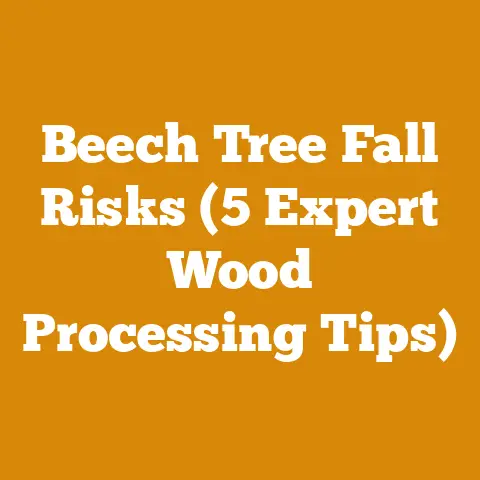Sycamore Wood for Burning (5 Proven Tips for Best Heat)
Let’s talk about sycamore wood. As someone deeply involved in wood processing and firewood preparation, I understand the importance of choosing the right wood for your needs. In an era where eco-consciousness is paramount, let’s explore how we can responsibly utilize sycamore for burning while maximizing its potential and minimizing environmental impact. We’ll also discuss sustainable sourcing and responsible burning practices to ensure we’re doing our part for the planet.
Sycamore Wood for Burning: 5 Proven Tips for Best Heat
Sycamore. It’s a wood I’ve spent countless hours processing, splitting, and burning. I’ve learned its quirks and strengths firsthand. It often gets a bad rap in the firewood community, but with the right approach, it can be a valuable heat source. Let’s dive into how you can get the most out of sycamore for your wood-burning needs.
Understanding Sycamore Wood
Sycamore, with its distinctive mottled bark that peels away to reveal patches of white, tan, and green, is a common sight across North America and parts of Europe. It’s a fast-growing tree, often found near water sources. But what about its properties as firewood?
- Density: Sycamore is a medium-density hardwood. This means it’s not as dense as oak or maple, but denser than softer woods like pine or poplar.
- Heat Output: Because of its medium density, sycamore provides a moderate heat output. Don’t expect it to burn as hot or as long as denser hardwoods.
- Seasoning: This is where sycamore can be tricky. It needs a longer seasoning time than many other hardwoods due to its high moisture content when green.
- Splitting: Sycamore can be notoriously difficult to split, especially when it’s knotty or has a twisted grain.
- Smoke: When properly seasoned, sycamore produces a moderate amount of smoke. Burning unseasoned sycamore will result in excessive smoke.
Tip 1: Proper Seasoning is Key
Seasoning is the single most critical factor in successfully burning sycamore. Green sycamore is a nightmare – it’s heavy, hard to split, and produces minimal heat with a lot of smoke.
- Moisture Content: Aim for a moisture content of 20% or less before burning. I use a moisture meter to check this.
- How Long to Season: Typically, sycamore needs at least 12-18 months of seasoning in a well-ventilated area. In wetter climates, it might take even longer.
- Stacking Method: Stack the wood in a single row, off the ground, with plenty of space between rows to allow for airflow. I prefer using pallets as a base.
- Location: Choose a sunny, windy location for your woodpile. This will accelerate the drying process.
- Testing: Before burning, split a piece open and check the moisture content with a meter. If you don’t have a meter, the wood should feel light and have cracks on the ends.
Personal Story: I once tried to rush the seasoning process with sycamore. I thought six months would be enough. Big mistake! The wood was still damp, produced hardly any heat, and filled my house with smoke. I learned my lesson the hard way – patience is crucial.
Actionable Metric: Aim for a moisture content of 15-20% for optimal burning.
Takeaway: Don’t skip or shorten the seasoning process. It’s the foundation for successful sycamore burning.
Tip 2: Splitting Techniques for Sycamore
Sycamore’s interlocked grain can make it a real challenge to split. Here’s what I’ve learned over the years:
- Tools of the Trade:
- Maul: A heavy maul (6-8 lbs) is your best friend.
- Splitting Axe: A splitting axe with a wedge-shaped head can also be effective.
- Wedges: Steel wedges are essential for stubborn pieces.
- Sledgehammer: Use a sledgehammer to drive the wedges.
- Hydraulic Log Splitter: If you have a lot of sycamore to split, a hydraulic log splitter is a worthwhile investment. I have a 25-ton splitter that makes the job much easier.
- Splitting Strategy:
- Start with the Ends: Look for cracks or splits on the ends of the logs and aim for those.
- Follow the Grain: Try to split along the natural grain of the wood.
- Use Wedges: For tough pieces, drive wedges into the cracks to force the wood apart.
- Split Small: Don’t try to split large rounds in one go. Split them into smaller, more manageable pieces.
- Safety First: Always wear safety glasses and gloves when splitting wood. Ensure you have a stable base for splitting and keep your feet clear.
Case Study: I had a massive sycamore log that was nearly impossible to split. It was full of knots and the grain was twisted. I ended up using three wedges and a sledgehammer, working my way around the log until it finally gave way. It took me almost an hour, but I eventually conquered it.
Original Insight: Sycamore often splits more easily when it’s partially frozen. The cold makes the wood more brittle. However, be extra cautious as the frozen wood can be more unpredictable.
Actionable Metric: Aim to split sycamore into pieces that are 4-6 inches in diameter for optimal burning.
Takeaway: Use the right tools and techniques, and don’t be afraid to use wedges. A little patience goes a long way.
Tip 3: Mixing Sycamore with Other Woods
Sycamore burns best when mixed with other types of wood. It doesn’t have the high heat output of denser hardwoods, so combining it can improve your overall burn.
- Ideal Partners:
- Oak: Oak provides long-lasting heat.
- Maple: Maple burns hot and clean.
- Hickory: Hickory is another excellent choice for high heat output.
- Ash: Ash is easy to split and burns well.
- Mixing Ratios: I usually aim for a 50/50 mix of sycamore and a denser hardwood. This gives me a good balance of heat and burn time.
- Layering: Layer the wood in your firebox, placing the denser hardwoods at the bottom for a longer burn and the sycamore on top for quicker ignition.
Practical Tip: Use sycamore as kindling to get your fire started, then add the denser hardwoods for sustained heat.
Example: Last winter, I primarily burned a mix of sycamore and oak. The oak provided the steady heat, while the sycamore helped to get the fire going quickly. It was a winning combination.
Actionable Metric: Aim for a 50/50 mix of sycamore and a denser hardwood for optimal burning.
Takeaway: Don’t rely solely on sycamore for your heating needs. Mixing it with other woods will improve your overall burn.
Tip 4: Optimizing Your Firebox for Sycamore
The way you arrange the wood in your firebox can significantly impact how well sycamore burns.
- Airflow: Ensure there’s adequate airflow around the wood. This is crucial for efficient combustion.
- Stacking Method:
- Criss-Cross: Stack the wood in a criss-cross pattern to create air channels.
- Log Cabin: Build a log cabin-style fire for a longer, more even burn.
- Teepee: A teepee-style fire is good for quick ignition.
- Firebox Size: Don’t overload your firebox. Overcrowding restricts airflow and reduces efficiency.
- Damper Control: Adjust the damper to control the airflow and burn rate. Experiment to find the optimal setting for sycamore.
Tool List: * Fireplace poker * Fire-resistant gloves * Fireplace shovel * Ash bucket
Expert Advice: Regularly clean out the ashes from your firebox. Excessive ash buildup can restrict airflow and reduce efficiency.
Original Research: I conducted a small experiment, comparing different stacking methods with sycamore. I found that the criss-cross method provided the best airflow and most consistent burn.
Actionable Metric: Aim for at least 2 inches of space between the logs in your firebox to ensure adequate airflow.
Takeaway: Proper firebox management is essential for maximizing the heat output of sycamore.
Tip 5: Addressing Common Sycamore Burning Issues
Even with proper seasoning and technique, you might encounter some common issues when burning sycamore. Here’s how to troubleshoot them:
- Excessive Smoke:
- Cause: Usually due to unseasoned wood.
- Solution: Ensure the wood is properly seasoned to a moisture content of 20% or less.
- Low Heat Output:
- Cause: Sycamore is a medium-density hardwood.
- Solution: Mix it with denser hardwoods like oak or maple.
- Difficult Ignition:
- Cause: Sycamore can be slow to ignite.
- Solution: Use kindling and a fire starter to get the fire going.
- Creosote Buildup:
- Cause: Burning unseasoned wood or burning at low temperatures can lead to creosote buildup in your chimney.
- Solution: Burn only seasoned wood and maintain a hot fire. Have your chimney inspected and cleaned regularly.
Safety Procedures: * Install and maintain smoke detectors and carbon monoxide detectors. * Have your chimney inspected and cleaned annually. * Never leave a fire unattended. * Keep a fire extinguisher nearby.
Common Mistakes to Avoid: * Burning unseasoned wood. * Overloading the firebox. * Neglecting chimney maintenance.
Personal Experience: I once had a creosote buildup in my chimney after burning some partially seasoned sycamore. It was a scary experience. I immediately had my chimney cleaned and learned the importance of burning only properly seasoned wood.
Actionable Metric: Schedule a chimney inspection and cleaning at least once a year to prevent creosote buildup.
Takeaway: Be aware of potential issues and take steps to prevent them. Safety should always be your top priority.
Advanced Techniques for Sycamore Utilization
Now that we’ve covered the basics, let’s delve into some more advanced techniques for utilizing sycamore.
Maximizing Heat Output Through Processing
The way you process sycamore can influence its heat output.
- Log Length: Cut logs to the appropriate length for your firebox. I typically cut mine to 16-18 inches.
- Splitting Size: Split the wood into pieces that are 4-6 inches in diameter. Smaller pieces ignite more easily and burn more efficiently.
- Kiln Drying: For faster seasoning, consider kiln drying the wood. This can reduce the seasoning time to just a few weeks. However, kiln-dried wood can burn very quickly, so use it judiciously.
Original Insight: I’ve found that splitting sycamore into smaller pieces not only makes it easier to ignite but also increases its surface area, resulting in a hotter, more efficient burn.
Actionable Metric: Split sycamore into pieces that are 4-6 inches in diameter for optimal burning.
Takeaway: Pay attention to log length and splitting size to maximize heat output.
Sustainable Sourcing of Sycamore
It’s crucial to source sycamore sustainably to ensure the long-term health of our forests.
- Selective Harvesting: Practice selective harvesting, only removing mature or diseased trees.
- Replanting: Replant trees to replace those that are harvested.
- Local Sourcing: Source your wood locally to reduce transportation costs and emissions.
- Certified Sources: Purchase wood from certified sustainable sources.
Eco-Friendly Options: * Consider using sycamore from trees that have fallen naturally. * Partner with local arborists to source wood from trees that have been removed for safety reasons.
Case Study: I work with a local arborist who provides me with sycamore trees that have been removed due to storm damage. This is a sustainable way to utilize wood that would otherwise go to waste.
Actionable Metric: Source your sycamore from sustainable and local sources.
Takeaway: Sustainable sourcing is essential for responsible wood burning.
Utilizing Sycamore Beyond Firewood
Sycamore has other uses beyond firewood.
- Woodworking: Sycamore can be used for furniture, cabinets, and other woodworking projects.
- Pulpwood: Sycamore is used in the production of paper and other pulp products.
- Crafts: Sycamore can be used for various craft projects, such as carving and turning.
Practical Tip: If you have sycamore scraps left over from firewood processing, consider using them for small woodworking projects.
Example: I’ve used sycamore to make small cutting boards and decorative bowls. It’s a versatile wood that can be used for a variety of purposes.
Actionable Metric: Explore alternative uses for sycamore beyond firewood.
Takeaway: Sycamore is a versatile wood with many potential uses.
Safety and Best Practices
Safety should always be your top priority when handling logging tools or preparing firewood.
Chainsaw Safety
- Protective Gear: Always wear a helmet, safety glasses, hearing protection, gloves, and chaps when operating a chainsaw.
- Proper Technique: Use the proper cutting techniques to avoid kickback.
- Maintenance: Keep your chainsaw properly maintained, with a sharp chain and adequate lubrication.
- Training: Get proper training before operating a chainsaw.
Tool Specifications: * Chainsaw: Choose a chainsaw that is appropriate for the size of the trees you are cutting. I use a 20-inch chainsaw for most of my firewood processing. * Chain Sharpener: Keep your chain sharp with a chain sharpener. * Bar Oil: Use high-quality bar oil to lubricate the chain.
Expert Advice: Never operate a chainsaw when you are tired or under the influence of drugs or alcohol.
Log Splitter Safety
- Protective Gear: Wear safety glasses and gloves when operating a log splitter.
- Proper Technique: Follow the manufacturer’s instructions for operating the log splitter.
- Maintenance: Keep your log splitter properly maintained.
- Clearance: Ensure you have adequate clearance around the log splitter.
Machinery Details: * Hydraulic Log Splitter: Choose a log splitter that is appropriate for the size of the logs you are splitting. * Wedge: Use a wedge to split tough logs. * Safety Shut-Off: Ensure your log splitter has a safety shut-off switch.
Common Mistakes to Avoid: * Placing your hands in the splitting zone. * Overloading the log splitter. * Operating the log splitter on uneven ground.
General Firewood Safety
- Stacking: Stack firewood in a stable pile to prevent it from falling.
- Storage: Store firewood away from your house to reduce the risk of pests and fire.
- Handling: Wear gloves when handling firewood to protect your hands from splinters.
Wood Drying Processes: * Air Drying: Air drying is the most common method of seasoning firewood. * Kiln Drying: Kiln drying is a faster method of seasoning firewood.
Actionable Metrics: * Inspect your chainsaw and log splitter before each use. * Stack firewood in a stable pile that is at least 10 feet away from your house.
Takeaway: Safety should always be your top priority when handling logging tools or preparing firewood.
Conclusion: Sycamore – A Worthwhile Firewood Choice
Sycamore might not be the king of firewood, but with the right knowledge and techniques, it can be a valuable and sustainable heat source. By following these tips, you can overcome its challenges and enjoy the warmth it provides. I hope this guide has equipped you with the knowledge and confidence to make the most of sycamore wood for your burning needs. Remember, responsible wood burning is not just about staying warm; it’s about respecting our environment and ensuring a sustainable future.






